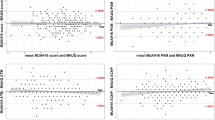Abstract
Background. In patients with hypertension noncompliance with drug treatment is between 15 to 54%, and has been recognised as a relevant contributor to the burden of cardiovascular morbidity. Up to 92% of patients experience unpleasant symptoms with their condition and, particularly in these patients, the symptoms experienced may enhance compliance.
Objective. To simultaneously assess the effects of physical, social and psychological factors on noncompliance.
Methods. Patients with mild hypertension despite drug treatment, from the departments of cardiology and internal medicine, were requested to answer a self-administered questionnaire addressing the presence of physical symptoms as well as psychosocial factors. The questionnaire was based on previously used test batteries and consisted of two lists of physical complaints and four lists addressing the four domains of planned behaviour regarding medical non-adherence according to Baron and Byrne. These domains mainly assess psychosocial factors. Each list consisted of three or more items and each item was scored on fiveto seven-point scales. Mean scores were used for assessment. The lists were also separately assessed for internal consistency and reliability using Cronbach’s alphas. One-way analysis of variance and multivariate analysis of variance (MANOVA) with compliance as outcome variable and the physical, social and psychological variables as indicator variables were used for data analysis. MANOVA was adjusted for multiple testing.
Results. Many patients experienced physical symptoms due to hypertension, such as tiredness (31%), hot flushes (28%), headache (24%), reduced daily life energy (23%), palpitations (22%), with 95% confidence intervals between 16 to 38%. Scores for physical symptoms and social factors did not differ between self-reported adherers (n=165) and nonadherers (n=11). However, the score for psychological factors was significantly larger in the adherers than in the non-adherers, 5.05 versus 3.06, p<0.018. The MANOVA showed a significant overall difference between the adherers and non-adherers in the data at p<0.012, which was mainly due to the score for psychological factors. Conclusion. The effect of physical symptoms on non-compliance in mildly hypertensive patients is negligible. So is the effect of social factors. Psychological factors such as lacking a sense of guilt, regret and shame are major determinants of non-compliance. Physicians may play an educational role in improving their patients’ compliance by addressing these determinants. We should add that the conclusions should be made with reservations, given the small number of non-adherers in our sample. (Neth Heart J 2008;16:197-200.)
Similar content being viewed by others
References
Haynes RB, Taylor DW, Sacket, DL. Compliance in health care. Baltimore: Johns Hopkins University Press, 1979.
Miller LC, Murphy R, Buss HA. Consciousness of Body: Private and Public. J Pers Soc Psychol 1981;41:397-406.
Lehane E, McCarthy G. An examination of intentional and unintentional aspects of medication non-adherence in patients diagnosed with hypertension. J Clin Nurs 2005;16:698-706.
Cramer JA. Consequences of Intermittent Treatment for Hypertension: The Case for Medication Compliance and Persistence. Am J Manag Care 1998;4:1563-8.
Meyer D, Leventhal H, Gutmann M. Common-Sense Models of Illness: The Example of Hypertension. Health Psychol 1985;4:115-35.
Baumann LJ, Leventhal H. “I can tell when my blood pressure is up, can’t I?” Health Psychol 1985;4:203-18.
Cantillon P, Morgan M, Dundas R, Simpson J, Bartholomew J, Shaw A. Patients’ perceptions of changes in their blood pressure. J Hum Hypertens 1997;11:221-5.
Galton L. The silent disease: Hypertension. New York: Crown, 1974.
Fahrenberg J, Franck M, Baas U, Jost E. Awareness of blood pressure: interception or contextual judgement. J Psychosom Res 1995; 39:11-8.
Brondolo E, Rosen RC, Kostis JB, Schwartz JE. Relationship of Physical Symptoms and Mood to Perceived and Actual Blood Pressure in Hypertensive Men: A Repeated Measures Design. Psychosom Med 1999;61:211-8.
Lau RR, Bernard TM, Hartman KA. Further explorations of common-sense representations of common illnesses. Health Psychol 1989;8:195-219.
Baron RA, Byrne D. Social Psychology. Boston: Pearson, Allyn and Bacon, 2000.
Author information
Authors and Affiliations
Corresponding author
Additional information
Department of Social and Organisational Psychology, University of Groningen, Groningen, the Netherlands
Martini Hospital, Groningen, the Netherlands
IJsselmeer Hospitals, Flevoland, the Netherlands
Streekziekenhuis Midden Twente, Hengelo, the Netherlands
Claude Bernard University, Lyon, France
Correspondence to: T. Cleophas Department of Medicine, Albert Schweitzer Hospital, PO Box 444, 3300 AK Dordrecht, the Netherlands
Rights and permissions
About this article
Cite this article
Okken, V.S., Niemeijer, M.G., Dijkstra, A. et al. The effect of physical, social and psychological factors on drug compliance in patients with mild hypertension. NHJL 16, 197–200 (2008). https://doi.org/10.1007/BF03086145
Issue Date:
DOI: https://doi.org/10.1007/BF03086145



